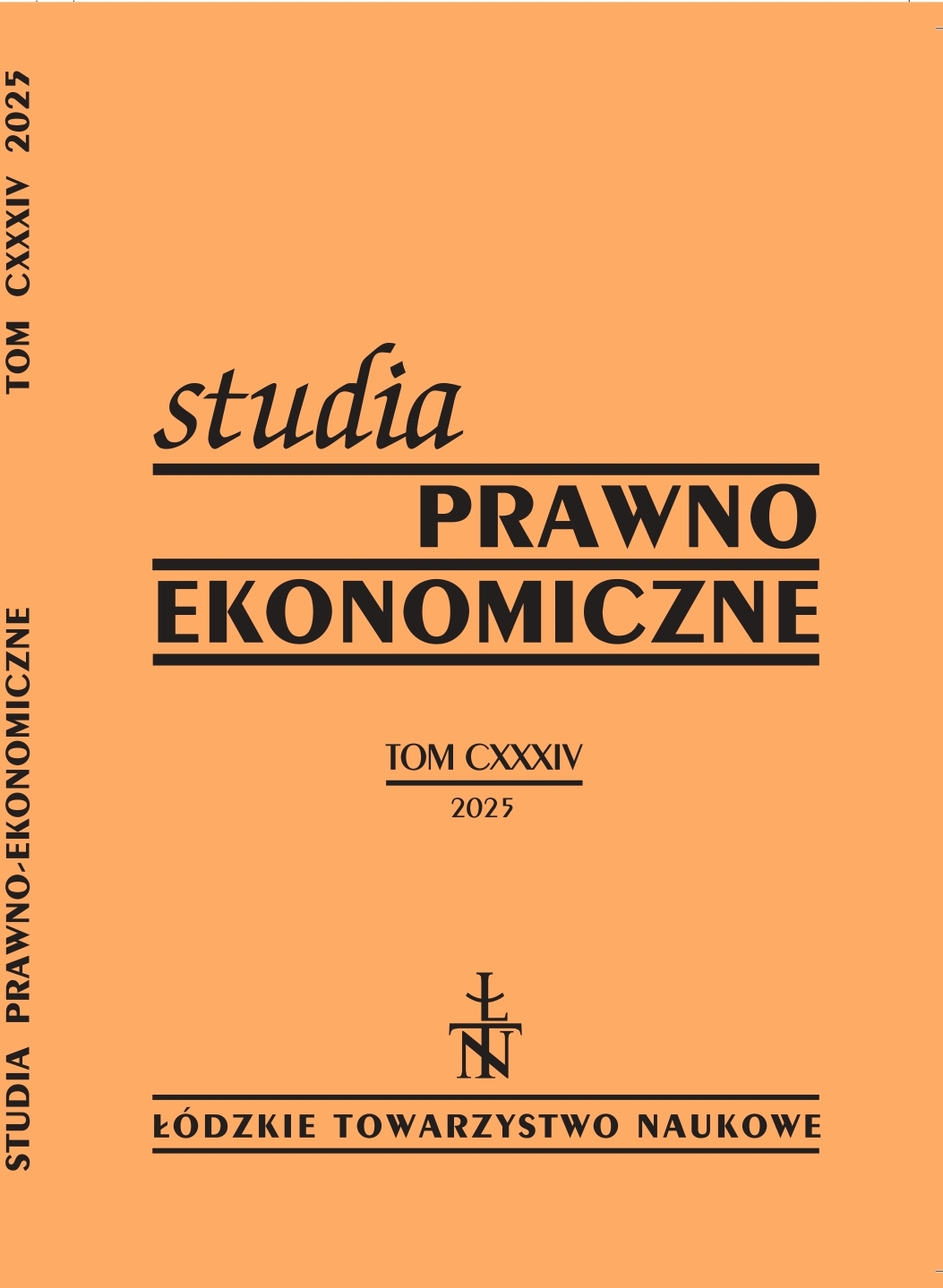Differences in bond valuations in portfolios of Polish investment funds
DOI:
https://doi.org/10.26485/SPE/2025/134/6Keywords:
bonds, fair value, Catalyst, trading liquidity, investment fundsAbstract
Background: The entry into force on January 1, 2021 of the Regulation of the Minister of Finance, Funds and Regional Policy of December 28, 2020, amending the regulation on special accounting principles for investment funds introduced numerous changes in the rules for the valuation of investment fund assets, in particular instruments not listed on the so-called active market, the role of valuation using a model or the definition of an active market itself.
Research purpose: To present and discuss the effects of the new legal regulations in relation to Polish bonds, particularly in the context of low liquidity in the public market for these instruments; to answer the question of whether, and if so, to what extent, differences are observed in the valuations of bonds carried out by investment funds operating on the Polish market under the aforementioned legal and market conditions. Furthermore, the research investigates whether the regulatory changes have contributed to an increase or decrease in these differences.
Methods: The study employed two methods: a critical-comparative analysis of legal acts and literature, and a statistical-empirical analysis.
Conclusions: Legal regulations leave funds with considerable discretion in defining the criteria for an active market and constructing the valuation models used in the absence of a price from an active market. This is reflected in the differences in the valuations of the same bonds by different TFIs, which pose challenges for institutions acting as depositaries, obliged to verify the correctness of asset valuations by funds.
Downloads
References
Rozporządzenie Ministra Finansów z dnia 24 grudnia 2007 r. w sprawie szczególnych zasad rachunkowości funduszy inwestycyjnych (Dz.U. z 2007 r., nr 249, poz. 1859).
Rozporządzenie Ministra Finansów, Funduszy i Polityki Regionalnej z dnia 28 grudnia 2020 r. zmieniające rozporządzenie w sprawie szczególnych zasad rachunkowości funduszy inwestycyjnych (Dz.U. z 2022 r., poz. 2436).
Allen F., Carletti E., Mark-to-Market Accounting and Liquidity Pricing, Journal of Accounting and Economics 2008/45 (2–3), s. 358–78, http://dx.doi.org/10.2139/ssrn.919900
Bao J., Pan J., Wang J., The Illiquidity of Corporate Bonds, The Journal of Finance 2011/66, s. 911–946, https://doi.org/10.1111/j.1540-6261.2011.01655.x
Barth M.E., Fair Value Accounting: Evidence from Investment Securities and the Market Valuation of Banks, The Accounting Review 1994/69 (1), s. 1–25, https://www.jstor.org/stable/248258; stan na 1.02.2024 r.
Bartosiak E., Roi się od modeli w funduszach obligacji korporacyjnych, 2022, https://www.analizy.pl/tylko-u-nas/30240/roi-sie-od-modeli-w-funduszach-obligacji-korporacyjnych; stan na 1.02.2024 r.
Cici G., Gibson S., Merrick J.J. Jr., Missing the Marks: Dispersion in Corporate Bond Valuations Across Mutual Funds, Journal of Financial Economics 2010/101 (1), s. 206–226, https://doi.org/10.1016/j.jfineco.2011.02.001
Cici G., Zhang P.A., On the valuation skills of corporate bond mutual funds, Review of Finance 2024/28 (6), s. 2017–2049, https://doi.org/10.1093/rof/rfae028
Gąsior T., Szydłowski M., Praktyczne aspekty wyceny składników lokat funduszy inwestycyjnych po zmianach regulacji w zakresie ich rachunkowości, w: J. Nesterak, A. Wodecka-Hyjek (red.), Dylematy i metamorfozy współczesnego zarządzania, Instytut Nauk Ekonomicznych PAN, Warszawa 2021.
Gemra K., Grzywacz J., Koszt finansowania przedsiębiorstw na rynku Catalyst w latach 2009–2013, w: J. Ostaszewski, E. Kosycarz (red.), Rozwój nauki o finansach. Stan obecny i kierunki jej ewolucji, Oficyna Wydawnicza SGH, Warszawa 2014.
Goldstein M.A., Hotchkiss E.S., Providing liquidity in an illiquid market: Dealer behavior in US corporate bonds, Journal of Financial Economics 2020/135, s. 16–40, https://doi.org/10.1016/j.jfineco.2019.05.014
Huang A.G., Wermers R.R., Xue J., Zhou X.A., Bond Valuation Dispersion and ETF Creation, 2024, https://ssrn.com/abstract=5046012; stan na 1.02.2024 r., http://dx.doi.org/10.2139/ssrn.5046012
Jędrzejka D., Problemy rachunkowości instrumentów finansowych w czasie kryzysu, Ekonomiczne Problemy Usług 2009/43, s. 107–119.
Kidyba A. (red.), Dumkiewicz M., Kapijas M., Kmieć J., Młynkiewicz K., Nowak A., Sadkowski C., Wojciechowski R., Ustawa o funduszach inwestycyjnych. Komentarz, Tom 1: Art. 1–157, Warszawa 2018.
Kordela D., Nowe rynki giełdowe – analiza i ocena rozwoju, Finanse, Rynki Finansowe, Ubezpieczenia 2015/73, s. 659–669.
Kozdra K., Rynek Catalyst w finansowaniu przedsiębiorstw, Zeszyty Naukowe PWSZ w Płocku, Nauki Ekonomiczne 2020/2, s. 235–246.
Kubiczek J., Corporate Bond Market in Poland – Prospects for Development, Journal of Risk and Financial Management 2020/13 (12), s. 1–13.
Laux Ch., Leuz Ch., Did Fair-Value Accounting Contribute to the Financial Crisis?, Journal of Economic Perspectives 2010/24 (1), s. 93–118, https://doi.org/10.2139/ssrn.1487905
Linsmeier Thomas J., Financial Reporting and Financial Crises: The Case for Measuring Financial Instruments at Fair Value in the Financial Statements, Accounting Horizons 2011/25 (2), s. 409–417, https://doi.org/10.2308/acch-10024
Martysz C.B., Królikowska A., Nieprawidłowości i nadużycia w zakresie wyceny funduszy inwestycyjnych, Rozdział 2, Oficyna Wydawnicza SGH, Warszawa 2023.
Mazur A., Wartość godziwa – potencjał informacyjny, Difin, Warszawa 2011.
Miziołek T., Ewolucja przepisów prawnych dotyczących depozytariuszy na rynku funduszy inwestycyjnych w Polsce, Ruch Prawniczy, Ekonomiczny i Socjologiczny 2022/84 (2), s. 27–42, https://doi.org/10.14746/rpeis.2022.84.2.2
Nikolaos S., Giannopoulos V., IFRS 9 Financial Assets: Debt Instrument Classification and Management Under the New Accounting Standard – A Case Study of Greek Government Bonds in Banks’ Investment Portfolios, w: P. Alhonse, K. Bouaiss, P. Grandin, C. Zopounidis (red.), Essays on Financial Analytics, Springer 2023, s. 175–120, https://doi.org/10.1007/978-3-031-29050-3_10
Plantin G., Sapra H., Shin H.S., Marking-to-Market: Panacea or Pandora’s Box?, Journal of Accounting Research, 2008/46(2), s. 435–60, https://doi.org/10.1111/j.1475-679X.2008.00281.x
Wilczyński R., Rozwój Rynku Obligacji w Polsce, w: J. Duraj, A. Sajnóg (red.), Ekonomiczne i Pozaekonomiczne Czynniki Zarzadzania Wartością Przedsiębiorstw, Wydawnictwo Uniwersytetu Łódzkiego, Łódź 2013.
UKNF, Raport dotyczący sytuacji finansowej towarzystw funduszy inwestycyjnych w 2022 roku, Warszawa 2023.
https://gpwcatalyst.pl/statystyki; stan na 1.02.2024 r.
https://www.izfa.pl/raporty#aktywa-raport; stan na 1.02.2024 r.
Publikacja rozporządzenia zmieniającego rozporządzenie w sprawie szczególnych zasad rachunkowości funduszy inwestycyjnych, https://krwlegal.pl/aktualnosci/publikacja-rozporzadzeniazmieniajacego-rozporzadzenie-w-sprawie-szczegolnych-zasad-rachunkowosci-funduszyinwestycyjnych; stan na 1.02.2024 r.
Downloads
Published
How to Cite
Issue
Section
License
Copyright (c) 2025 Studia Prawno-Ekonomiczne

This work is licensed under a Creative Commons Attribution 4.0 International License.



